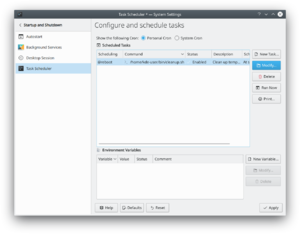System Settings/Task Scheduler/it: Difference between revisions
Created page with "* Inserisci un comando (facoltativo). Dovrebbe essere descrittivo, in modo da spiegare cosa fa l'operazione: non sempre è ovvio." |
Created page with "* Fai clic su '''Abilita questa operazione''' per abilitarne l'esecuzione." |
||
| Line 24: | Line 24: | ||
* Inserisci un comando (facoltativo). Dovrebbe essere descrittivo, in modo da spiegare cosa fa l'operazione: non sempre è ovvio. | * Inserisci un comando (facoltativo). Dovrebbe essere descrittivo, in modo da spiegare cosa fa l'operazione: non sempre è ovvio. | ||
* | * Fai clic su '''Abilita questa operazione''' per abilitarne l'esecuzione. | ||
* Click '''Run at system bootup''' to enable the script to run each time the system is booted. | * Click '''Run at system bootup''' to enable the script to run each time the system is booted. | ||
Revision as of 22:22, 5 August 2024
Informazioni generali
Il Pianificatore di operazioni è un'interfaccia grafica al classico programma "cron". Con esso i comandi (o "operazioni") possono essere eseguiti ad orari specifici, in certi giorni o in certe date, oppure a intervalli specifici (tempo tra le esecuzioni).

Utilizzo
In KDE 4.4 KCron è un modulo accessibile in . Se non è presente controlla di aver installato il pacchetto kdeadmin. In KDE 4.5 lo troverai in . Alcune distro creano un pacchetto separato per KCron, dunque se non lo vedi dovresti cercare questo termine nel tuo repository.
Aggiunta e modifica delle operazioni
Fai clic su per aggiungerne una nuova, oppure "Modifica" per modificarne una esistente: verrà visualizzata la pagina Aggiungi o modifica operazione esistente.

- Inserisci il comando da eseguire. Fai clic sull'icona a cartella per sceglierla dalla finestra.
- Inserisci un comando (facoltativo). Dovrebbe essere descrittivo, in modo da spiegare cosa fa l'operazione: non sempre è ovvio.
- Fai clic su Abilita questa operazione per abilitarne l'esecuzione.
- Click Run at system bootup to enable the script to run each time the system is booted.
- Click Run every day to enable the script to run every day. This will automatically select the appropriate options.
- Using the buttons, choose when the command should be run. Not all parameters are required, those not needed may be left blank.
- Hours and Minutes are the time of day to run the task, not an interval.
- When done, click . The task will be added and scheduled if enabled.
Removing a task
To completely remove a task, select the task from the list and click the Delete button. This will permanently remove the task.
Environment Variables
Sometimes a task or multiple tasks need a specific variable set, it must be added in the Environment Variables section. The cron utility uses its own environment, system-wide and user-specific variables are not used. Click New Variable to add a new variable definition, or Modify to change an existing variable.
- Enter the name of the variable to use. This name:
- Must consist of letters, digits, and underscore ('_') only
- Must start with a letter
- Should not be a reserved or commonly used system variable. See https://pubs.opengroup.org/onlinepubs/000095399/basedefs/xbd_chap08.html for more information
- The value the variable will contain. This can be a number or string.
- Enter a brief description of the variable.
Suggerimenti
- Tutti i file che vengono modificati si trovano nella cartella /etc/cron dove ci sono numerosi file da guardare.
- Lo strumento a riga di comando che ti permette di vedere i cron-jobs attualmente definiti è
crontab -l
(l'ultima è la lettera L).
Maggiori informazioni
- KDE official documentation
- Cron (Wikipedia)
- Cron (Arch Linux wiki)

